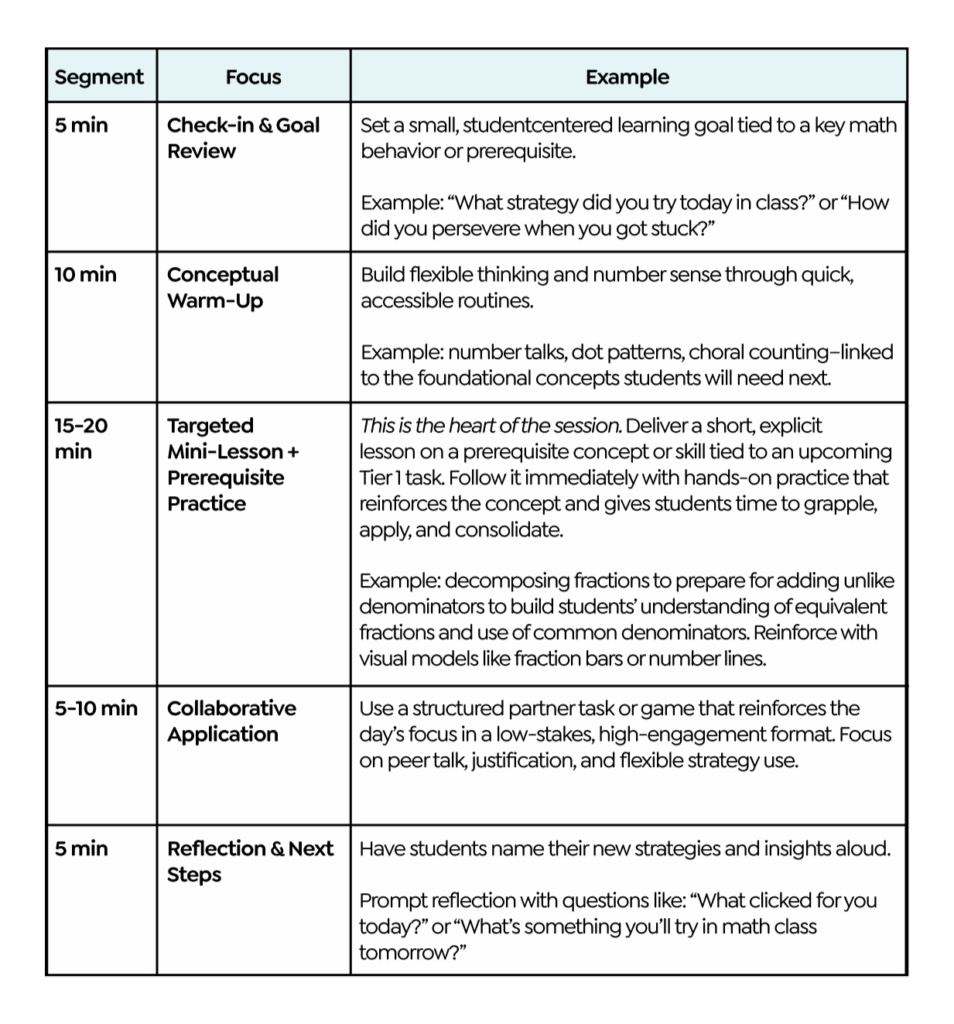Too often, when students struggle in math, we respond with more of the same—more worksheets, more rote procedures, more pressure. But what if we flipped the script? What if we designed math supports not just to catch students up, but to build their confidence, deepen their conceptual understanding, and provide them with the tools to thrive in Tier 1 instruction?
That’s the promise of MTSS in mathematics when it’s done right.
MTSS in Mathematics: A Vision for Equity and Access
 A Multi-Tiered System of Supports (MTSS) is not a sorting mechanism—it’s a framework for ensuring every learner gets what they need, when they need it, in a way that builds identity, agency, and understanding. In math, this means:
A Multi-Tiered System of Supports (MTSS) is not a sorting mechanism—it’s a framework for ensuring every learner gets what they need, when they need it, in a way that builds identity, agency, and understanding. In math, this means:
- Tier 1 is inclusive, high-quality, universally designed math instruction for all.
- Tier 2 is timely, targeted, and skill-specific support for students who need a boost.
- Tier 3 is intensive and individualized, often delivered in smaller settings or with specialized staff.
But the magic lies in how these tiers work together. Tier 2 isn’t a destination—it’s a bridge back to Tier 1.
What Belongs in Tier 2 Math?
Tier 2 support in math isn’t just “more math.” It’s strategic intervention designed to address prerequisite skills and conceptual gaps that are currently preventing access to grade-level content. This includes:
- Number sense and place value
- Basic fact fluency (with a conceptual foundation)
- Multiplicative reasoning
- Fraction concepts and operations
- Mathematical language and vocabulary
- Executive function strategies for problem solving
These supports must be data-driven, anchored in learning progressions, and laser-focused on the just-right skills that help students unlock Tier 1 learning.
Designing WIN Time or Support Classes That Work
WIN (What I Need) time or math support classes are ideal structures for Tier 2. But they only work if designed with intention. Here’s what effective Tier 2 math support should look like:
1. Rooted in Data and Progressions
Start with a clear picture of what students can do, then identify the specific prerequisites they need to access the current unit in Tier 1. Use:
- Universal screener data
- Common formative assessments
- Error analysis from classwork
- Interviews or student reflections
Align the intervention to the learning progression connected to your priority standards—not the textbook pacing.
2. Short-Term and Flexible
Tier 2 supports should be:
- Short cycles (4–6 weeks)
- Groupings that change based on need
- Explicit entry and exit criteria
Avoid locking students into static support classes. Tier 2 is not a life sentence.
3. Strengths-Based and Identity-Affirming
Support classes should build confidence, not reinforce the idea that students “aren’t good at math.” Focus on:
- Celebrating growth, not just “catching up”
- Reconnecting students to their strengths
- Building a mathematical identity: *”I’m a problem solver,” “I can figure things out.”
This is particularly important for multilingual learners and historically marginalized students.
4. Hands-On, Conceptual, and Language-Rich
Avoid drill-and-kill. Use activities that:
- Emphasize conceptual models and manipulatives (e.g., area models for multiplication)
- Connect to real-world problems
- Encourage math talk, justification, and collaborative sensemaking
Remember, developing procedural fluency without understanding is a false shortcut.
Sample Structure: A Tier 2 Math Support Session
Here’s a snapshot of what a 30–45 minute Tier 2 support class could look like. The structure is deliberately designed to target prerequisite skills needed to unlock upcoming Tier 1 instruction.
 Check out these tier 2 math support session examples for 1st, 4th, 7th, and 10th grade math classes.
Check out these tier 2 math support session examples for 1st, 4th, 7th, and 10th grade math classes.
When does prerequisite practice happen?
It lives within and after the mini-lesson, where students engage with previously missed or underdeveloped skills in ways that feel connected to their classroom learning—not like a detour. This practice should mirror the thinking and representations students will see in Tier 1 but at a more accessible level of complexity and pacing.
Final Thoughts: Build Up, Don’t Water Down.
MTSS in math is not about separating students from challenges—it’s about strategically preparing them to meet it. Prerequisite skills are not “remedial” content; they are the essential building blocks for conceptual understanding and mathematical confidence. These supports align with the Standards for Mathematical Practice, such as making sense of problems, reasoning abstractly, and constructing viable arguments—all essential for success in Tier 1.
When Tier 2 time is rooted in identity, purpose, and progression-based design, it becomes a launchpad for success—a place where students re-enter Tier 1 ready to contribute, engage, and grow.
Let’s reimagine support not as a place students go when they’re behind, but as a space where students build the foundation to soar.
Call to Action
We have an opportunity—and a responsibility—to ensure that every student sees themselves as a mathematician. MTSS in math isn’t about tracking students or diluting expectations. It’s about dismantling barriers, affirming student identity, and designing supports that empower all learners to engage meaningfully with rigorous, grade-level content. When we treat Tier 2 as a scaffold and not a silo, we create the conditions for lasting mathematical confidence, curiosity, and achievement.
If your school is rethinking MTSS in math, start by asking:
- Are we clear on what students need to access Tier 1?
- Are we designing Tier 2 learning on big ideas, learning progressions, and pre-requisite skills?
- Do our support classes include time for targeted practice that prepares students for what’s next?
- Are our supports identity-affirming and asset-based?
When math intervention is thoughtful, equitable, and purposeful, students don’t just catch up—they move forward with confidence.
Want to go deeper and be part of a movement that centers learner agency and collaborative inquiry? Join the Impact Team movement and explore how to transform teaching and learning through shared leadership, formative assessment, and equitable support.
References
- Boaler, J. (2016). Mathematical mindsets: Unleashing students’ potential through creative math, inspiring messages and innovative teaching. Jossey-Bass.
- Council of the Great City Schools. (2021). Addressing unfinished learning after COVID-19 school closures: The case for acceleration. https://www.cgcs.org/cms/lib/DC00001581/Centricity/Domain/313/CGCS_Unfinished_Learning.pdf
- Fuchs, L. S., & Fuchs, D. (2006). Introduction to response to intervention: What, why, and how valid is it? Reading Research Quarterly, 41(1), 93–99. https://doi.org/10.1598/RRQ.41.1.4
- Gersten, R., Beckmann, S., Clarke, B., Foegen, A., Marsh, L., Star, J. R., & Witzel, B. (2009). Assisting students struggling with mathematics: Response to intervention (RtI) for elementary and middle schools. National Center for Education Evaluation and Regional Assistance, Institute of Education Sciences. https://ies.ed.gov/ncee/wwc/PracticeGuide/2
- Moschkovich, J. N. (2013). Principles and guidelines for equitable mathematics teaching practices and materials for English language learners. Journal of Urban Mathematics Education, 6(1), 45–57.
- National Council of Teachers of Mathematics. (2014). Principles to actions: Ensuring mathematical success for all. NCTM.
- Sánchez, M. T., & Sale, P. D. (2011). Building response to intervention (RTI) from the ground up: A practical guide for elementary school teachers. Corwin Press.
- Smith, M. S., Steele, M. D., & Raith, M. L. (2017). Taking action: Implementing effective mathematics teaching practices in grades 6–8. National Council of Teachers of Mathematics.
- Tomlinson, C. A. (2014). The differentiated classroom: Responding to the needs of all learners (2nd ed.). ASCD.
- Zwiers, J., & Crawford, M. (2011). Academic conversations: Classroom talk that fosters critical thinking and content understandings. Stenhouse.



